If the quantity of pictures are any indication of the amount of fun one has when traveling, then this week is near the top with 135 shots taken! Trying to figure out how to edit them down is a problem I don’t mind having!
After circumnavigating the island of Antigua last week, we were fortunate enough to rendevzous with good friends from the Carib1500 rally — Arctic Tern, Asseance, Villomee and Heaven Won’t Wait. This was the largest gathering of rally boats that we had see since leaving the BVI’s, and what fun it was! Through a stroke of good fortune, we all ended up in Jolly Harbor, Antigua. Bob and Linda from Villomee were nice enough to have everyone over for appetizers on the first night. It was a good thing, as, even though their boat is 47 feet long as well, it has an immense, canvas-enclosed cockpit that can hold an army of sailor friends who will jump at the first mention of “Hey, why don’t you stop over a little later today…”!

Just so you know the who’s-who of our sailing scene these days, pictured from left to right it is Heather and Don (Asseance), Richard (Heaven Won’t Wait), Bob (standing) and Linda (Villomee), Marni (HWW), yours truly, and Hunter (Arctic Tern). Our hosts, Bob and Linda, are fellow Californians. Bob is retired from many years in the Navy as well as being a geologist and Linda used to be a CEO of a healthcare company. They are the nicest couple you can wish to meet on the water. Bob’s voice is frequently heard on the morning Single Side Band chat. As many of us as are available get on the radio at 7:30am and if the conditions are right, rally boats from the Bahamas to Grenada can catch up, tell stories, and give helpful advice. We last ran into Bob and Linda when we were at anchor at Saba, just before we discovered our broken rudder, so it was truly jolly to run into them under better circumstances in Jolly Harbor. Hunter and his wife Devi (who was flying back from Florida at the time of the picture) are both phenomenal naturalists. They are both retired from the Natural Park Service and bring their depth of knowledge to bear helping us understand what species we are seeing, on the water and on land. When the kids are around them listening closely, I can’t help but think this is the best classroom field trip they could ever have wished for. As for the rest of the folks in the picture — Don and Heather from Asseance and Richard and Marni from Heaven Won’t Wait — I’ve mentioned them in past updates, but they are both our good Canadian friends. Heather has a non-stop supply of energy and helps to keep the kids going on outings. She always has the right item in her backpack to share for the moment, whether it is a bandaid, a granola bar, or a French-English dictionary. Richard, Marni and their son Devon had just completed a heroic double overnight push from Tortola to Antigua with no visible sign of fatigue – quite impressive! They had to return to Halifax for family business for a month and upon hearing that we were all mustering in Antigua, pushed themselves to join us. It was a great reunion!
Our playtime with the gang continued the next night as we gathered ashore at the Dogwatch restaurant, supposedly a cruiser’s hangout. We didn’t see too many other bedraggled folks like us, but several of us enjoyed burgers from the spot with the ‘fourth best burger in the Caribbean’, served by a rather surly waitress who came through at the end of the meal with a beautiful serenade (click here for video). To wrap up the evening, we walked down the path a few restaurants to enjoy a spot still open that served ice cream. Later, with the kids in bed at 11pm, Karen and I knew we’d be paying the price the next morning as we tried to get them back into their lessons!
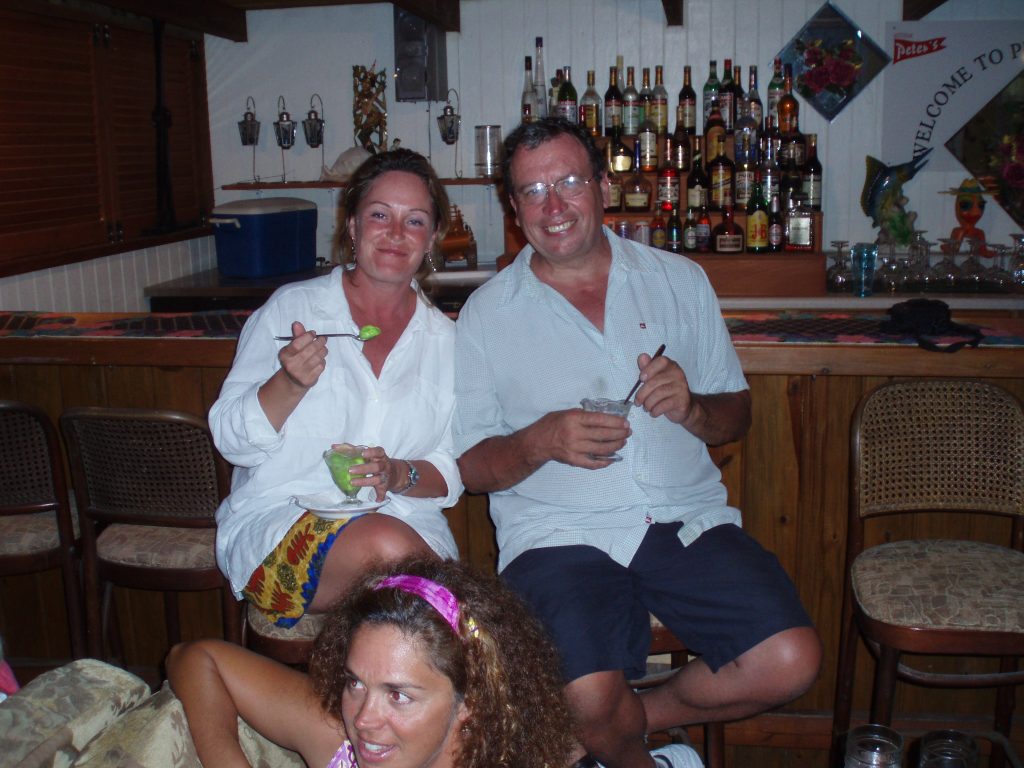
One of the reasons so many of us had ended up in Jolly Harbor was due to the good provisioning and other services such as hardware and internet access. This is an example of some of the helpful advice we get on the SSB radio each morning, as the guidebook we have is a bit dated and services can come and go quickly down here. Jolly Harbor is mostly comprised of the Jolly Harbor Marina and Resort, a development of several hundred tastefully done condos, each on the water with their own dock. Most of them seemed empty, but to service this clientele, the town had the best marine store on the island, and the grocery store could go toe-to-toe with any major store in the States. Yet, if you were to go to Falmouth and English harbors, as we did earlier the previous week, the only grocery store you could find was the equivalent of a dinky little convenience store you might see straddling a corner in a big city, with big city prices. And, this was in a harbor with more money sunken into megayachts then buried in King Tut’s tomb! I can only assume that they pay to have their supplies airlifted to them!
For the rest of us mere mortals, we are constantly on the hunt for decent provisioning outlets. On the last day in Jolly Harbor, Karen and three of the other women took an outing to the island’s main city, St Johns, to ostensibly shop at a farmer’s market. I was a little concerned that this was a rouse for a ‘girls day off’, but she brought back this one picture and many colorful stories to go with it, so I am foreced to take her word on it!
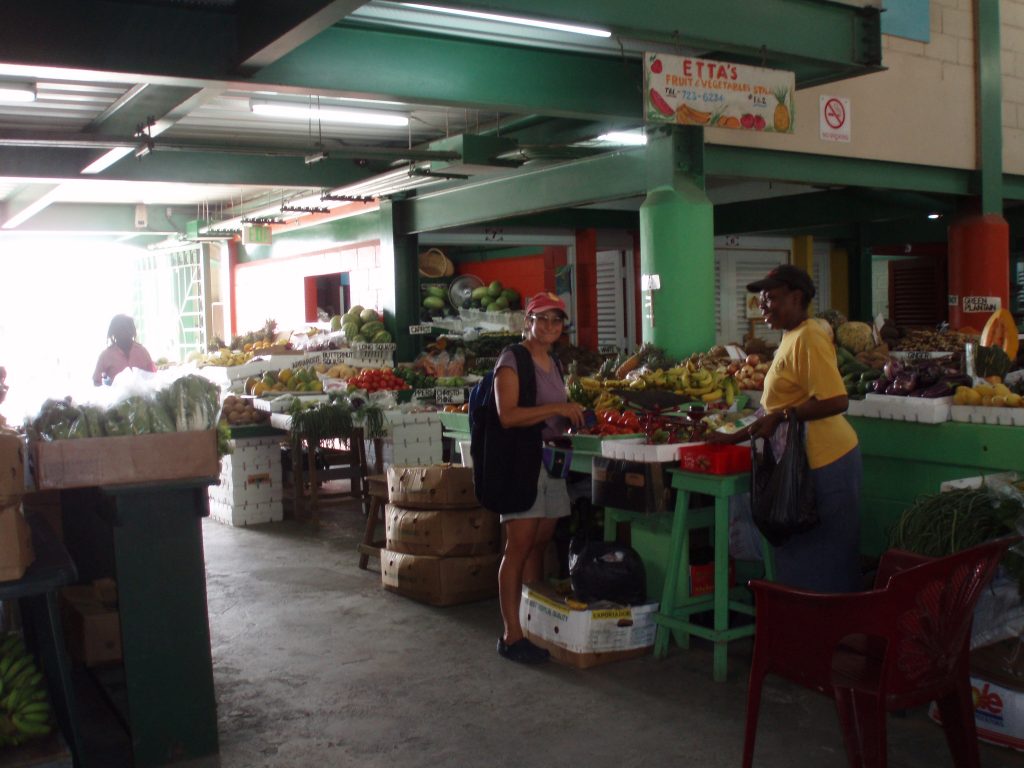
On Wednesday morning, with our boat’s fuel and water tanks full, and our refrigerators and fruit hammocks bursting with local food, four boats – Heaven Won’t Wait, Asseance, Arctic Tern and ourselves – headed off together for a 50 mile sail south to Guadeloupe. The winds were peaking at about 20 knots and the waves – coming to us broadside – sometimes caught us unaware and soaked the cockpit, but we had a grand time watching the knotmeter climb into the 8’s. We were not accustomed to be sailing with other boats to the same destination, so we spent a welcome degree of it on the radio chatting. Our first challenge radioed out to the fleet was to come up with a name for our group. Each boat was allowed several entries, and after the radio-based voting was complete, we agreed to call our event ‘The Deshaies (DAY-hay) Dash’, named for our planned landfall on Guadeloupe!
We had been told by other cruisers that Deshaies is a good spot to start a visit to Guadeloupe, with its wonderful botanical gardens a short walk out of town and a good jumping off point to see the rest of the island. We ended up doing both, with a walk to the botanical garden on the first day and a self-guided tour of the island by rental mini-bus on the next two days. Guadeloupe is part of France, and while most of our Canadian contingent spoke some French, our savior was Richard with his near-fluent French. Some cruisers we talked to were frustrated in Guadeloupe (as well as Martinique) because everything is in French – road signs, menus , etc – and it is the rare sole on the street that can speak English, so we had more reason then ever to thank Richard for being part of the Deshaies Dash! How lucky we had been on the other islands to have so much written and spoken English.
Here’s a story in pictures about the splendid Botanical Gardens.

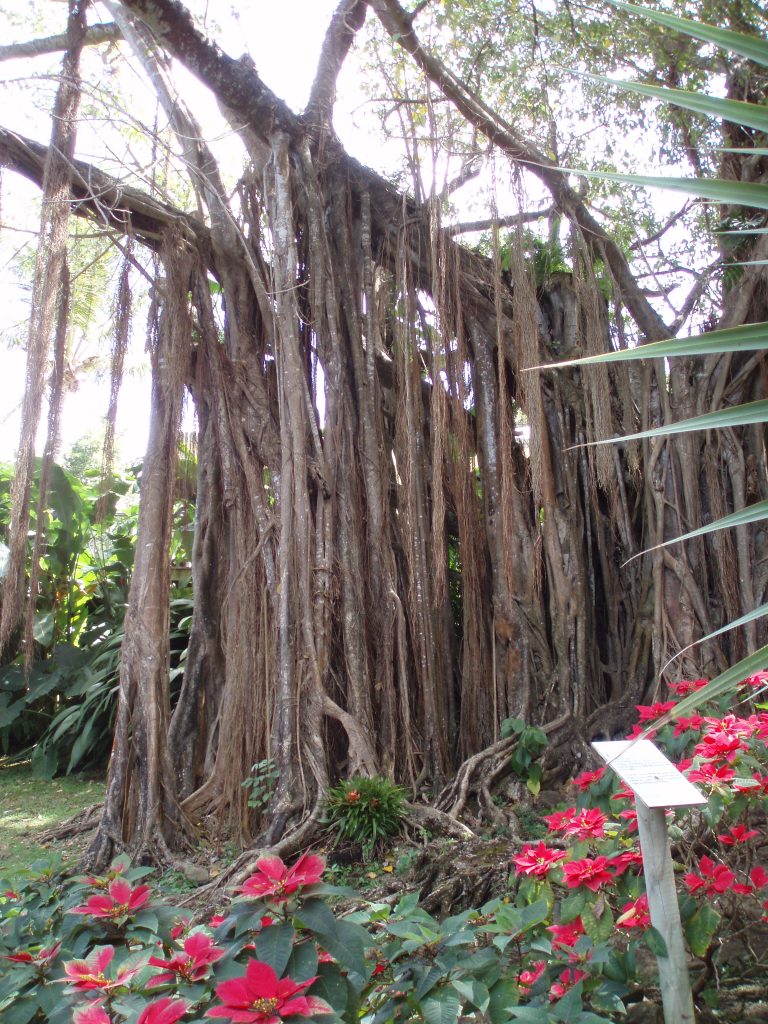
And you thought I had long hair!! This is a Banyan tree that is being slowly suffocated by vines. The vines grow up the trunks, out the limbs and hang down until they reach the ground, rooting themselves further and spreading out enough to block sunlight and nourishment to the tree.
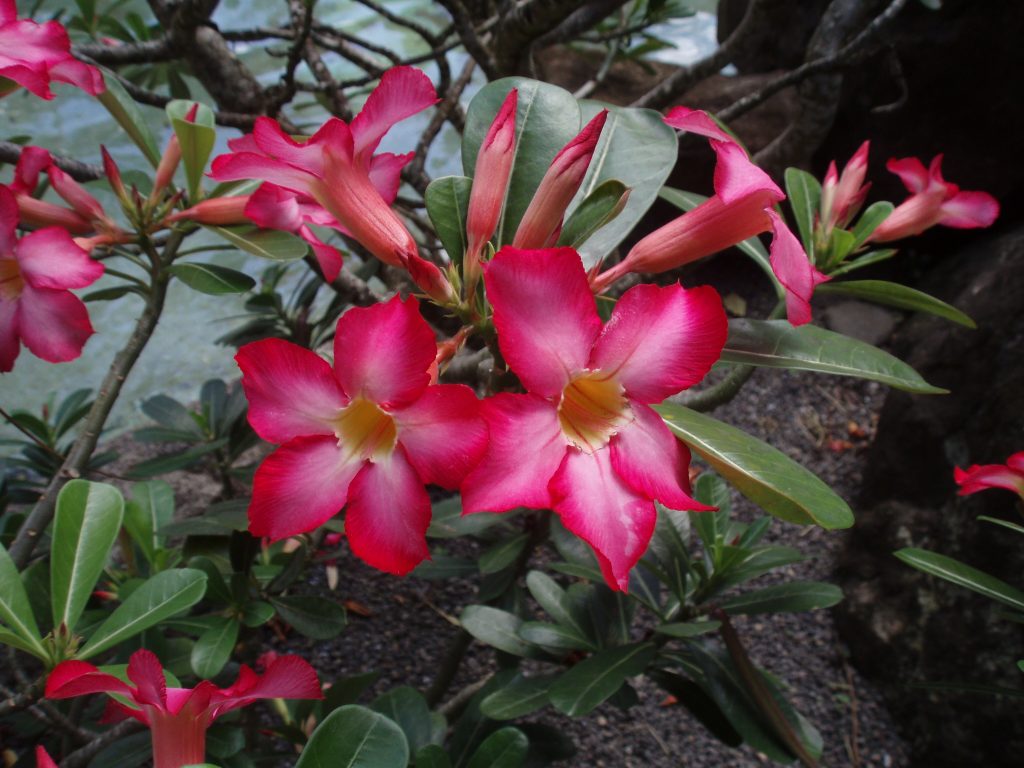

Banana trees are a dime-a-dozen in the tropics, but purple bananas – now there’s something a little different!
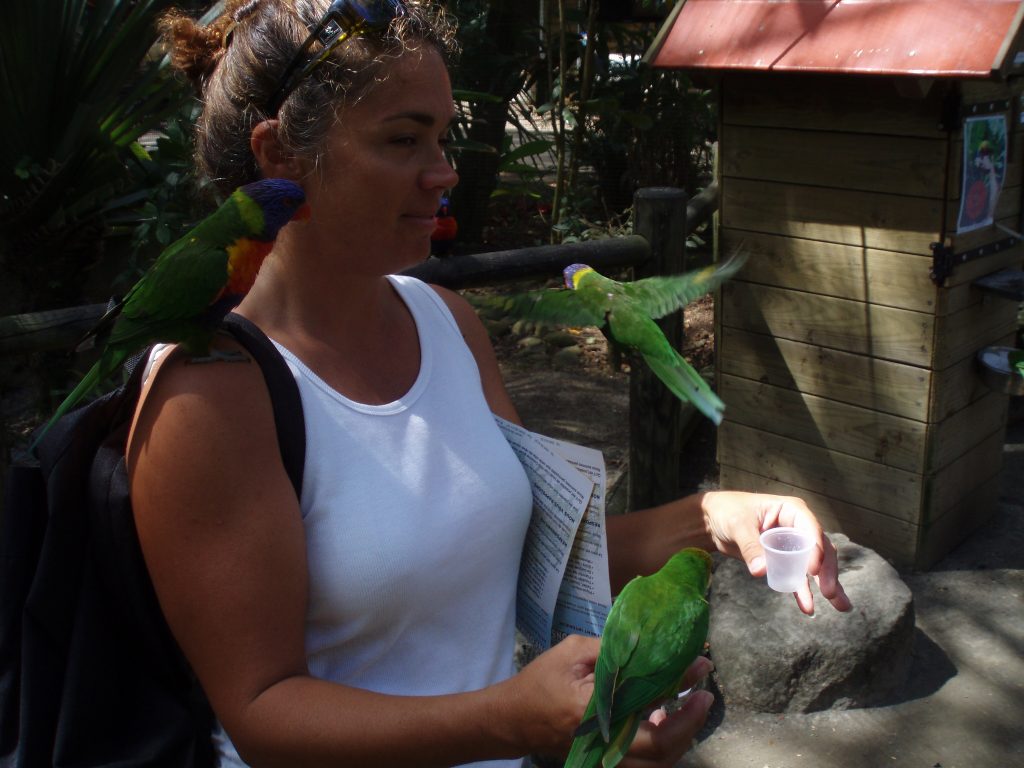
Once we figured out the confusing French instructions on the bird food dispenser, these colorful parrots arrived in droves.
For our next two days in Guadeloupe, Richard drove us around in our Ford Transit mini-bus, much like a minivan in the States, but smartly appointed to hold 9 passengers comfortably. This was no Ford Winstar, but something with a definitive European flair! Our first outing was to the rain forests. Guadeloupe has several tall peaks all over 1000 meters, the highest of which is still an active volcano, La Soufriere, at 1397 meters. Like many of the islands in this area, the tall peaks create their own weather systems, resulting in large amounts of rain and nearly continuous clusters of clouds engulfing the peaks. In fact, the average rainfall in Guadeloupe is 6 1/3 meters per year. That is about 250 inches per year, or 2/3rd of an inch per day! And, with this next picture, you’ll see that we experienced every bit of that rain! We ventured forth on a hike to Chutes de Carbet, the Carbet Waterfalls, and what started out as a hike in the mist ended up in a torrential downpour once we were too far to respectfully turn back to the car!
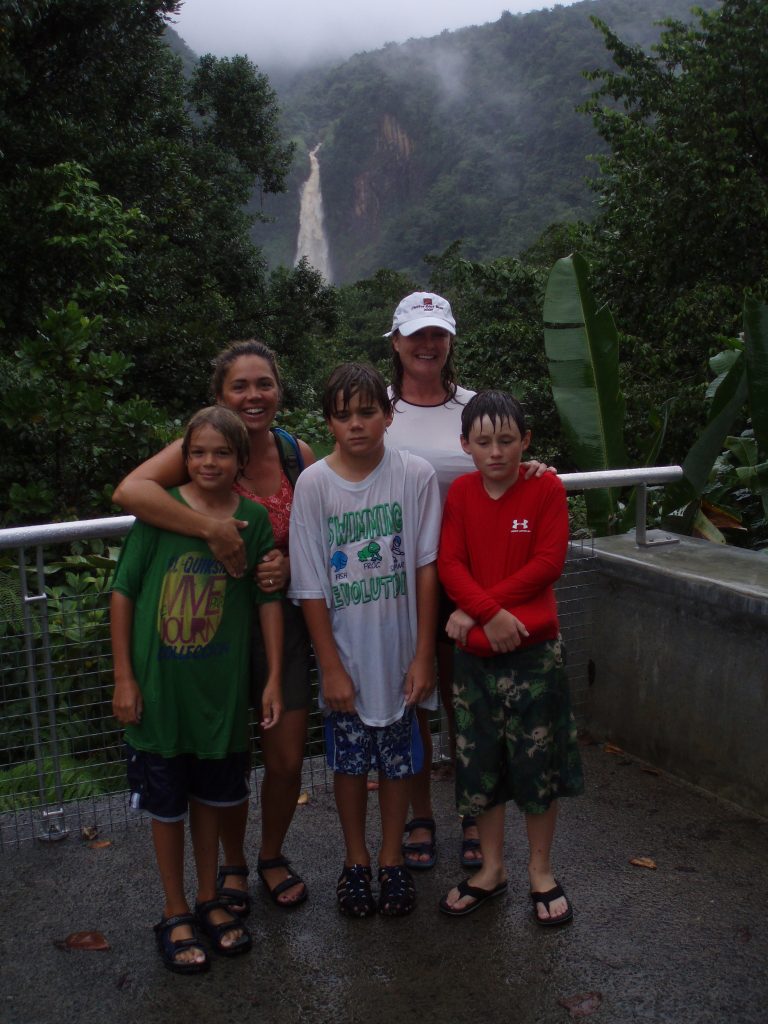
But it was not all misery. We stopped at another spot named Cascade aux ecrevisses, or Crayfish Waterfalls and though we didn’t see any crayfish we did discover the wonders of swimming under a waterfall. This is a frequent stop on the tour bus route, but we luckily caught it on a more peaceful morning. From Karen’s expression, you can see it was a bit colder than the warm tropical ocean water we had grown accustomed to!
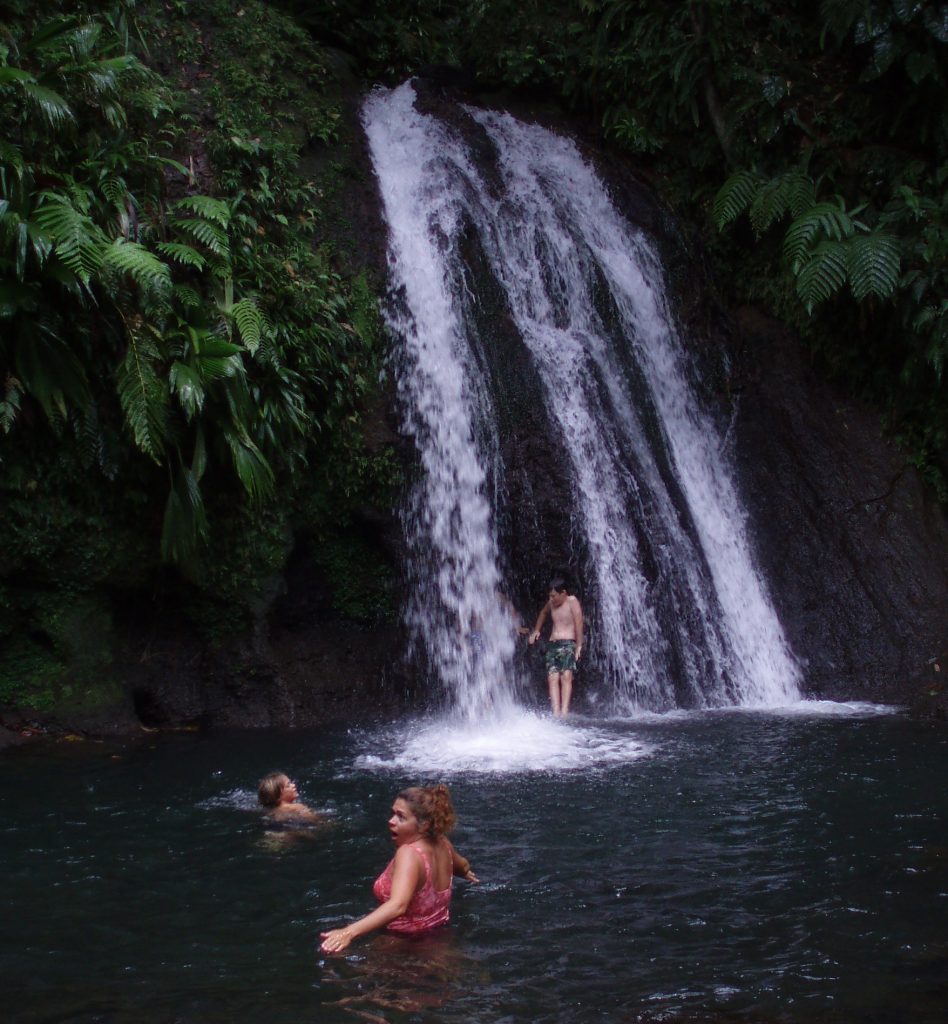
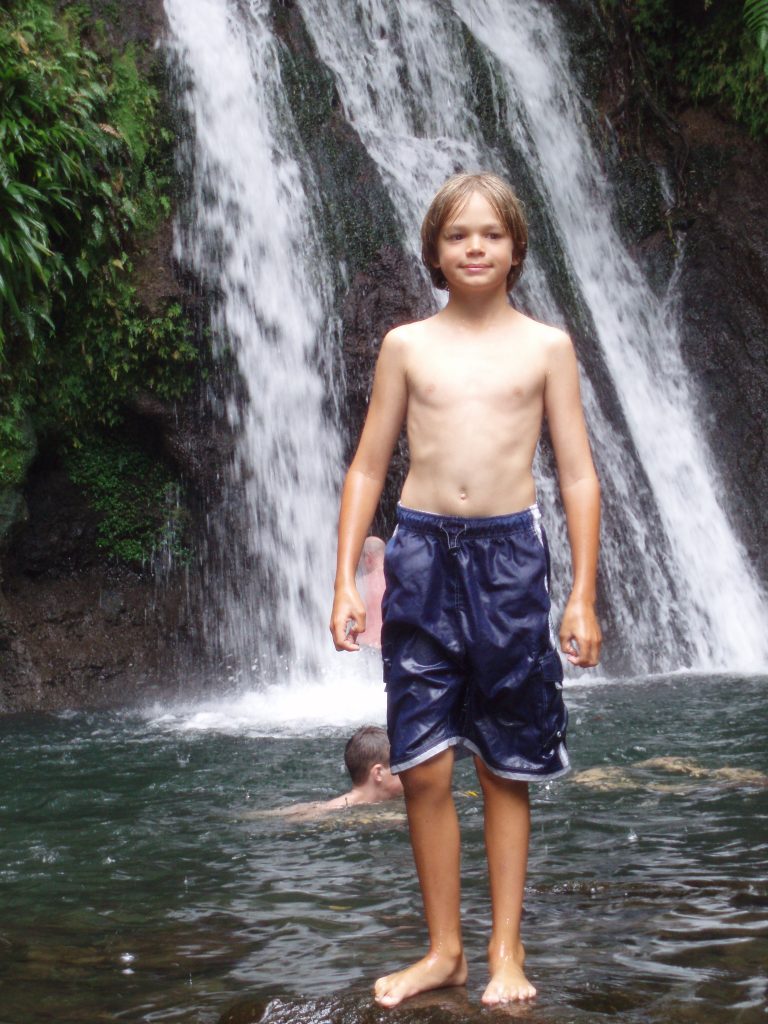
The minute you step on to the land of Guadeloupe, you can tell this is unlike many other Caribbean islands. The French influence is clearly evident in how well maintained they keep the towns, buildings and streets. You have to search hard to find garbage left on the streets. They have many easily found garbage bins, disguised just enough behind gates so that they aren’t an eyesore. The road signs, though they are in French, are at nearly every intersection. The center of the island, where the mountains, rain forest, and volcano reside is a national park, and they did a great job creating and signing many trailheads into the forest. They seem to have found that delicate balance for a tropical island – making a natural treasure accessible to visitors without it becoming overrun and abused. Hats off to the French National Park organization!!
On our second day of mini-bus exploring, we visited an oft-recommended site called the Musee de Rhum. Yes, they did tell us a lot about rum, but lest you think we are fixated on the stuff, the museum had a very impressive display of old ship models and, oddly enough, one of the best insect collections you can find anywhere. Devi, with her National Park background and studies, said it was by far the largest display of bugs and other insects that she had ever seen. The Musee de Rhum produces what many people in France consider to be a fine example of rum, all from natively grown sugar cane. There was a second rum distillery on the island too, supplied by local sugar cane as well – an interesting contrast with St Kitts, an island that was once the king of sugar and now has ceased all production. In fact, Guadeloupe’s two main exports are sugar and bananas, so they must be doing something right. This island was starting to really appeal to us!
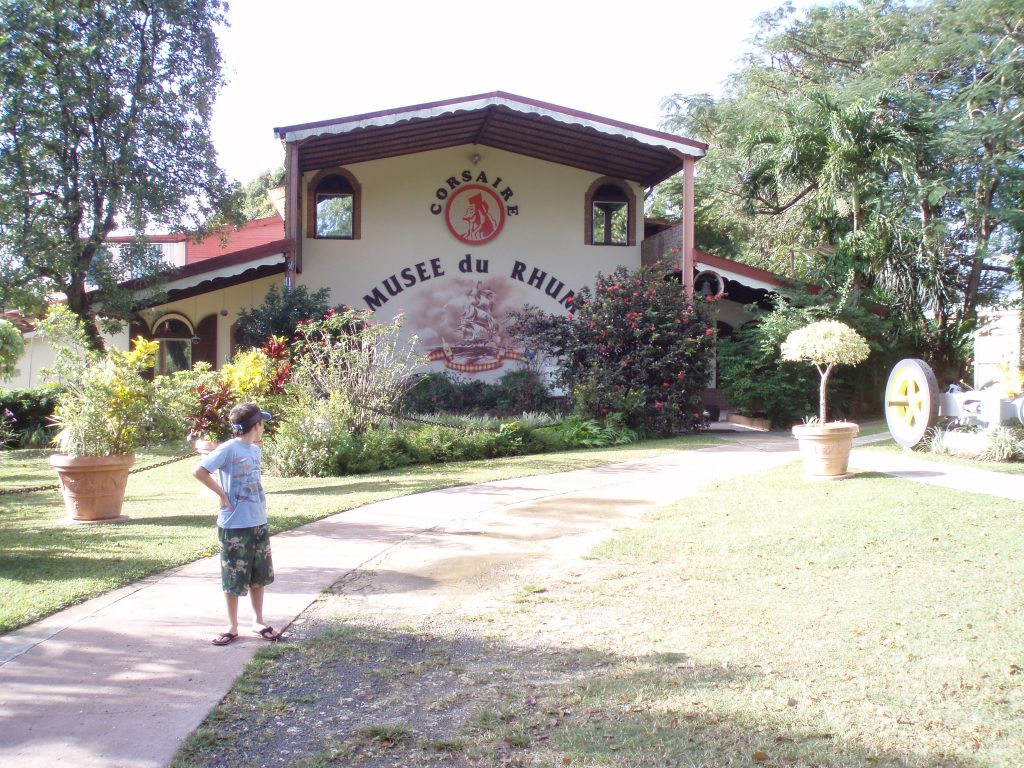
After the rum tasting was complete, at 10 am I might add, we headed over to the eastern side of Guadeloupe, a part of the island that was not nearly as mountainous, but with a number of fine beaches.
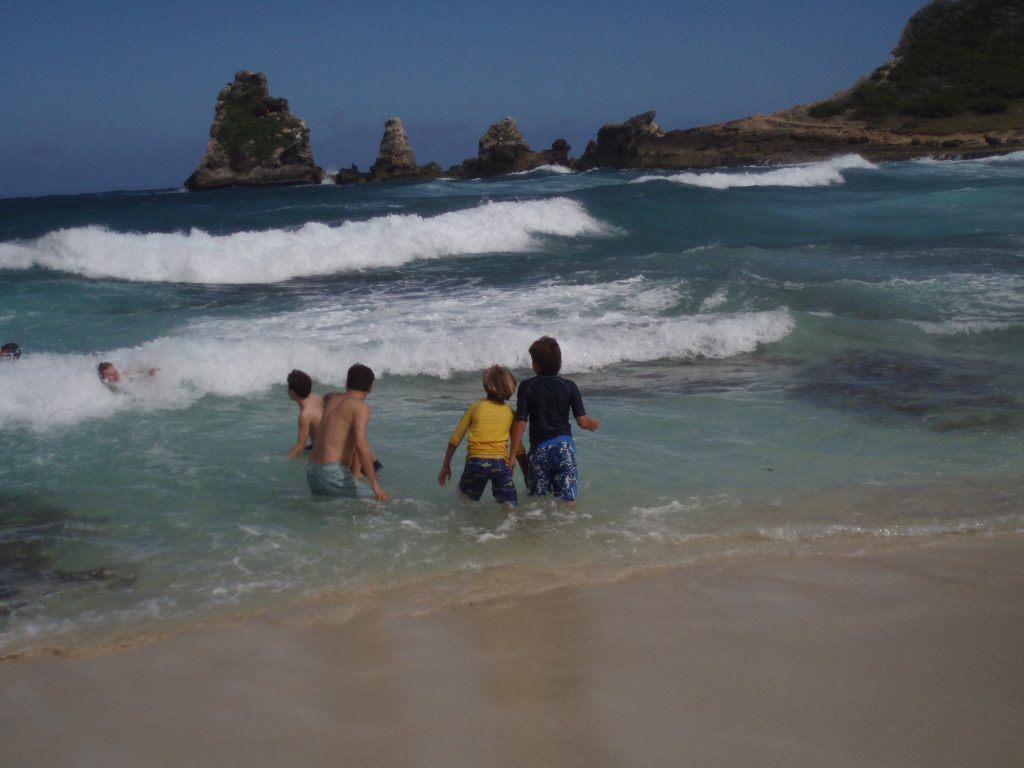
This spot was on a tip of land called Pointe Des Colibris on the extreme eastern end of what everyone commonly refers to as the upside down butterfly, as you will notice below. At this location, the seas making their way across the Atlantic meet those from the Caribbean Sea, and churn up a cauldron of frothy water. Bodysurfing here was nothing like it was on the beaches of Southern California during my youth!
Guadeloupe
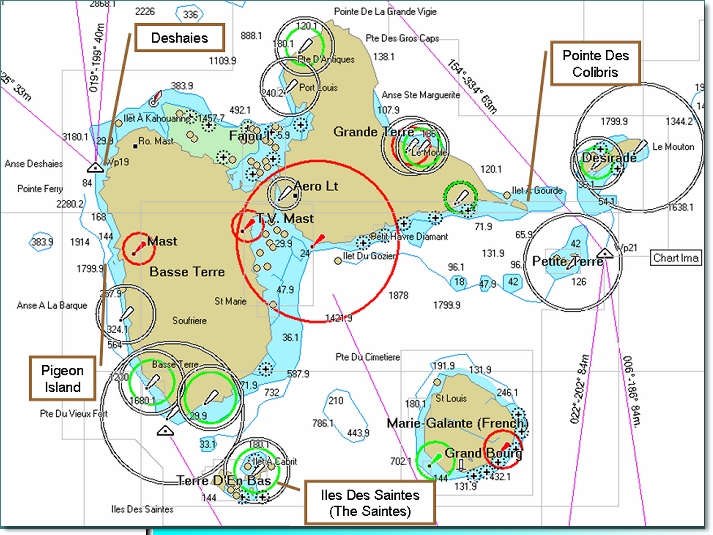
After spending three days in Deshaies, it was time to move on. We sailed down a quick 10 miles to Pigeon Island. Although it was over in less then 2 hours, you’d think from our exhausted state afterwards that it was a full day’s sail. On the westward (leeward) side of Guadeloupe, the wind has just finished roaring up the mountainous peaks and then, as it cools, comes racing down the backside and hits those of us trying to use the island as a wind shadow. The problem was, though, that it wasn’t predictable. At times it would be a manageable 15 knots, but as we passed abreast of gorges and gullies, the wind would race up to 20-30 knots. After several of these surprise blasts, we learned our lesson and put two reefs in the jib and main. It was a welcome relief to lay the anchor down at Pigeon Island, but the winds continued to howl the rest of the day and night. We weren’t the only ones caught off guard from the high winds. A group of 12 kayakers were scattered offshore trying to fight their way upwind and to the shore. One was capsized and in the water, unable to get the strength to right his kayak and climb in. Richard and I jumped into our dinghies and rescued three of them. It felt good to have a chance to pay it forward!
We will be leaving tomorrow for a cluster of islands called The Saintes just south of the butterfly but still part of Guadeloupe, and then on south to Dominica. It feels great to be moving steadily along through the islands, and even better to be in the company of good friends.
